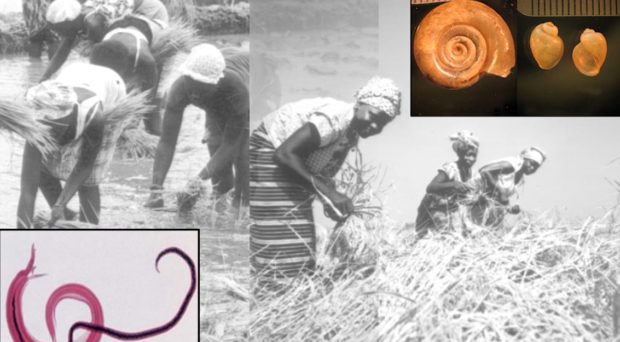
As the COVID-19 pandemic continues, it has become painfully evident how vulnerable economic systems can be to widespread and persistent diseases.
In low- and middle-income countries, particularly in sub-Saharan Africa, agriculture plays a fundamental developmental role as it constitutes the main component of the countries’ economies, employing more than half of the total workforce. Although mostly characterized by subsistence farming and by low productivity, agriculture remains the most powerful instrument for poverty alleviation, contributing to the diversification and growth of household income, and allowing access to improved production technologies.
Simultaneously, however, agricultural development facilitated by the construction of large-scale irrigation schemes foster the propagation of schistosomiasis, a water-based debilitating parasitic disease that affects an estimated 250 million people, more than 85% of whom live in sub-Saharan Africa. The parasite species that cause the two main forms of schistosomiasis in Africa are Schistosoma mansoni (causing intestinal schistosomiasis) and Schistosoma haematobium (causing urogenital schistosomiasis).
The disease is characterized by a complex life cycle involving two reproduction phases, the first is asexual in specific freshwater snail species that act as intermediate hosts, followed by sexual reproduction in the human host. In untreated humans, advanced forms of schistosomiasis lead to kidney failure, bladder cancer, liver fibrosis, as well as heightened risk of HIV transmission. The highest parasite burden is usually borne by school-age children and the disease has been linked to anaemia, stunting and cognitive deficits, leading to poor school performance and higher drop-out rates. The development and management of major water infrastructures, including irrigation canals and reservoirs, have modified the dynamics of the disease’s distribution through the expansion of suitable habitats for the intermediate host snails. Due to these long-term impacts, schistosomiasis is believed to exert large health, social and financial burdens on infected individuals, households and heavily affected communities.
Schistosomiasis dynamics, water resources development and economic development are therefore strongly interlinked. However, their concurrent effect and joint dynamics are yet to be fully explored. In our paper we fill this gap by studying the economic impact of schistosomiasis via its burden on agricultural production. We show that this burden is considerable: we estimate that eliminating schistosomiasis in Burkina Faso would increase average crop yields by around 7%, rising to 32% for high infection clusters. For a landlocked sub-Saharan country such as Burkina Faso, where 80% of the population works in the agricultural sector, this impact is particularly dramatic.
Consistent with the debilitating nature of the disease, we identify the economic burden of the disease to be one that does not directly affect the amount of labour or physical inputs (e.g. seeds and machinery) required for production but instead diminishes their effectiveness. In other words, chronic schistosomiasis causes farmers to be less able to farm efficiently: this generates a spiral of deleterious effects that can have potentially dramatic consequences, particularly in countries such as Burkina Faso where agriculture is mostly of the subsistence type.
To make matters worse, this burden is paradoxically reinforced both by poverty and by poverty-reducing measures such as water resources development. We find that poor households suffer a disproportionately higher burden (32% for high-intensity clusters) and that villages in close proximity of large dams experience a much higher agricultural yield loss due to schistosomiasis (around 20%).
Geography plays a pivotal role, as this increase in yield loss due to schistosomiasis is contained within a radius of 20-30km from the dams, and villages located at a further distance from the dams suffer a reduced burden. The consequences from the standpoint of inequality are substantial: these large water infrastructures are in majority built for hydroelectrical purposes and geared towards urban electrification. This means that those who live in the areas adjacent to the dams suffer the most deleterious consequences in terms of disease burden, whilst reaping only a small part of their benefits. Fortunately, our results are not entirely bleak. Smaller-scale water infrastructures, which are equally fundamental measures of poverty control, especially in the poorest parts of the sub-Saharan region, do not seem to amplify the economic burden of schistosomiasis, and hence should be incentivized and strengthened.

We obtain our results by exploiting recent developments in disease mapping. We obtain high-resolution schistosomiasis prevalence maps via Bayesian geostatistical methods, which have been used in a variety of public health contexts but have not yet been paired with survey data on households and agricultural production. Because of the complexity of the dynamics of schistosomiasis and its interlinkages with such a large set of socioeconomic and environmental factors, we implement a novel mix of methods. We use the spatial density of the snail intermediate host of the Schistosoma parasites to establish causality and refine the analysis with machine learning and spatial techniques.
Our study illustrates the potential benefits of combining epidemiological and economic methods in the analysis of the human cost of endemic diseases. Our approach is “data-hungry”, especially in the study of the impact of endemic diseases at a household level, which can represent a hurdle for wider application. Yet, recent methodological and technological advances increasingly allow researchers to access a wealth of information which was until recently unthinkable. Conditional on this, our approach can be applied to any other country in which schistosomiasis is endemic and indeed, to the economic impact of many other diseases.
Comments